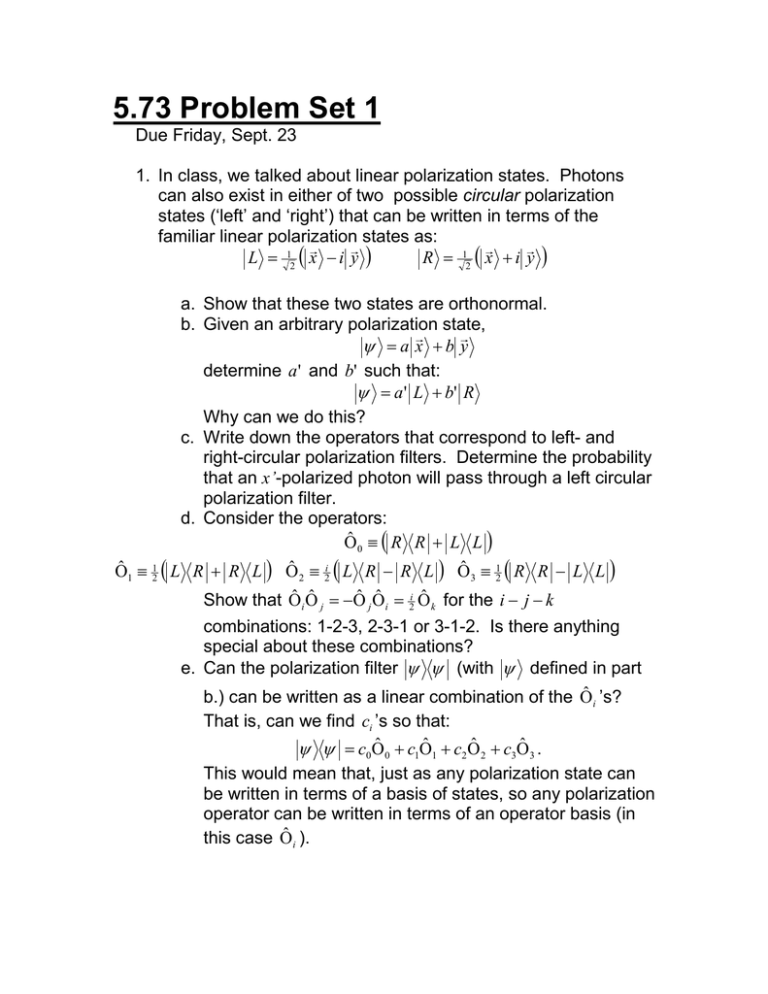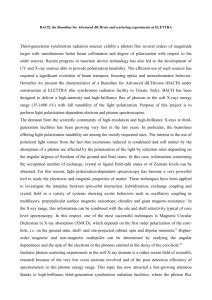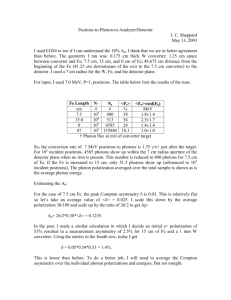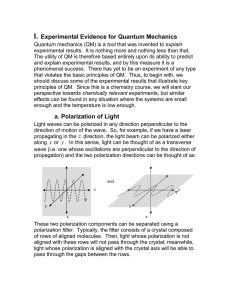5.73 Problem Set 1
advertisement

5.73 Problem Set 1 Due Friday, Sept. 23 1. In class, we talked about linear polarization states. Photons can also exist in either of two possible circular polarization states (‘left’ and ‘right’) that can be written in terms of the familiar linear polarization states as: � � � � R = 12 ( x + i y ) L = 12 ( x − i y ) a. Show that these two states are orthonormal. b. Given an arbitrary polarization state, � � ψ = a x + b y determine a ' and b' such that: ψ = a ' L + b' R Why can we do this? c. Write down the operators that correspond to left- and right-circular polarization filters. Determine the probability that an x’-polarized photon will pass through a left circular polarization filter. d. Consider the operators: ˆ 0 ≡ ( R R + L L ) Ο ˆ 3 ≡ 12 ( R R − L L ) ˆ 2 ≡ 2i ( L R − R L ) Ο ˆ 1 ≡ 12 ( L R + R L ) Ο Ο ˆ iΟ ˆ j = −Ο ˆ jΟ ˆ i = 2i Ο ˆ k for the i − j − k Show that Ο combinations: 1-2-3, 2-3-1 or 3-1-2. Is there anything special about these combinations? e. Can the polarization filter ψ ψ (with ψ defined in part ˆ i ’s? b.) can be written as a linear combination of the Ο That is, can we find ci ’s so that: ψ ψ = c0Οˆ 0 + c1Οˆ 1 + c2Οˆ 2 + c3Οˆ 3 . This would mean that, just as any polarization state can be written in terms of a basis of states, so any polarization operator can be written in terms of an operator basis (in ˆ i ). this case Ο 2. Consider a molecule that can undergo two photon emission (TPE) from its excited state, emitting two photons with the same energy to return to its ground state. After emission, denote the basis states of the two photons by: � � k1 ,θ1 ;k2θ 2 � where ki is the wavevector (direction of propagation) of photon i and θ i is its polarization. a. If we work in the frame of the molecule, the total momentum of the system will be zero both before and � after emission. What constraint does this place on the ki ? b. The polarization of the photon can be associated with an angular momentum, which must also be conserved. Thus, if photon 1 is right polarized, photon 2 is left polarized. Given this and the results of part a., write down a general expression for the state of � the system after TPE, given that photon 1 is emitted in the k -direction. c. Now after the two photons have traversed a macroscopic distance (say, 1 meter), we want to perform an experiment on photon 2. Determine the probability that photon 2 will pass through a left polarization filter. d. Now, suppose we first measure the polarization of photon 1 and determine that it is left polarized. Then, what is the probability that photon 2 will pass through a left polarization filter? Is this disturbing? Make sure to justify your answer using the rules discussed in class and/or bra-ket notation.









